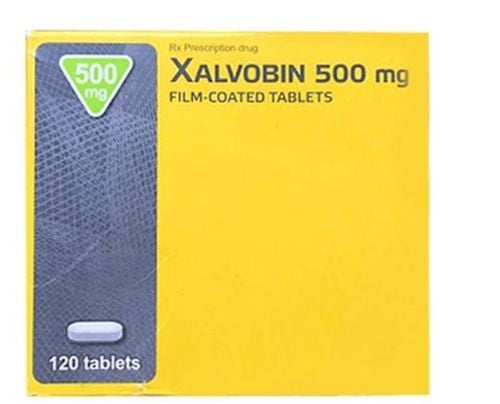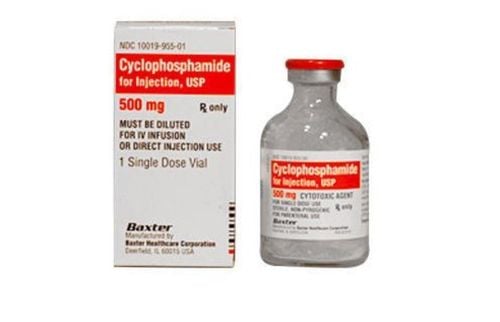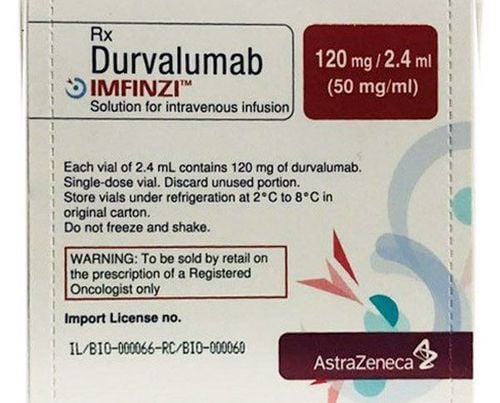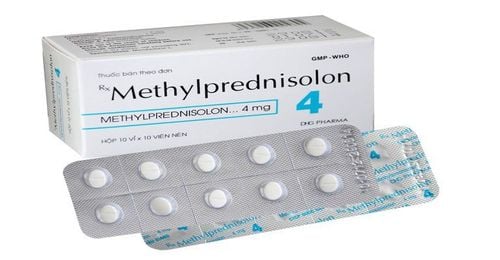This is an automatically translated article.
Radioactive iodine treatment for cancer is internal radiation therapy that uses a radioactive form of iodine. Radioactive iodine circulates throughout the body in the patient's blood. Cancer cells have the characteristic of absorbing iodine from anywhere in the body, so they will be destroyed.1. What is radioactive iodine?
Common iodine is one of the basic nutrients that the body needs and can be absorbed through food. The thyroid is a gland in the neck that normally uses iodine to make hormones that guide certain body functions such as growth and physical development.
When it comes to radiation, almost all of us feel it will cause bad things to our lives. However, with the development and scientific progress, radioactive iodine is being used by doctors as a very effective method in cancer treatment. With a small amount of radioactive iodine when applied to a person, a doctor can detect the disease with a special scanner. Accordingly, when using a larger dose of radioactive iodine, it can also destroy thyroid cancer, prostate cancer and some other diseases.
In the treatment of thyroid cancer, iodine is established into 2 forms of radioactive iodine commonly used in patients with thyroid disease: I-123 (harmless to thyroid cells) and I- 131 (destroys thyroid cells). The radiation emitted by each of these forms of iodine can be detected externally to the patient to obtain information on thyroid function and image the size and position of thyroid tissues. Radioiodine treatment is quite safe for people who already have seafood allergies or X-ray contrast agents, because the reaction is a compound containing iodine, not iodine alone.
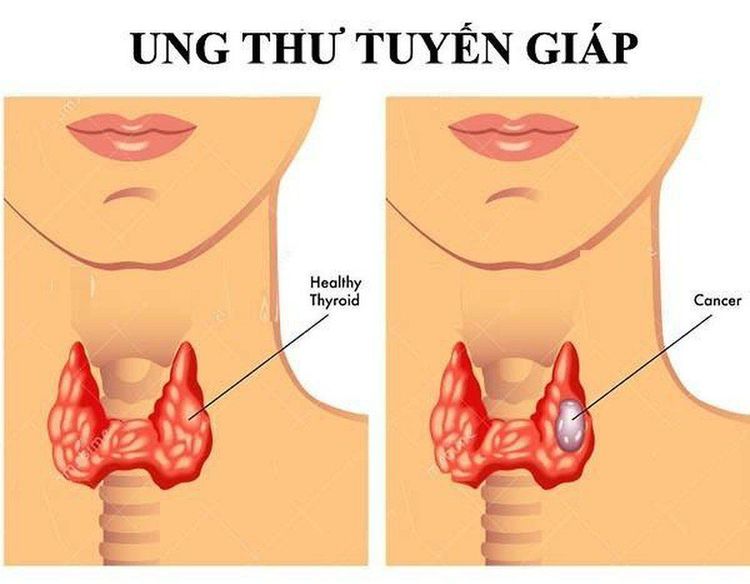
I-ốt phóng xạ được sử dụng trong điều trị ung thư tuyến giáp
2. Action of radioactive iodine
When the patient receives a dose of radioactive iodine in liquid capsule form, the thyroid gland absorbs all of it. So it can help your doctor check for a lump in your neck (thyroid cancer).
In addition, the doctor will also give the patient a very small dose of radioactive iodine in an injection or pill form. After a few hours, the doctor will use a special scanner that shows where the radiation has passed. Parts of the thyroid gland that show less radiation than the average person might suspect it to be cancer. At the same time, the doctor will use some other tests to confirm the diagnosis.
Accordingly, radioactive iodine also helps doctors diagnose whether cancer has spread beyond the thyroid gland.
3. Preparing for cancer treatment with radioactive iodine
For treatment to be effective, the patient needs to have high levels of thyroid-stimulating hormone (TSH or thyrotropin) in the blood. This hormone is what causes thyroid tissue and cancer cells to absorb radioactive iodine. If the thyroid gland has been removed, the doctor will use a number of supportive measures to increase TSH levels before receiving radioactive iodine therapy:
The first is to stop taking thyroid hormone medicine for a while. some week. This will cause thyroid hormone levels to become low (hypothyroidism), at which point the pituitary gland will secrete more TSH. Intentional hypothyroidism is only temporary, but it often causes symptoms such as fatigue, depression, weight gain, constipation, muscle pain, and decreased concentration. The second is that thyrotropin (thyrogen) can be injected which causes the thyroid hormone to be withheld for an unnecessarily long time. This medicine is taken for 2 days in a row and on the 3rd day will be treated with radioactive iodine. Most doctors will recommend that cancer patients stick to a low-iodine diet for 1 or 2 weeks before this treatment. This will avoid foods containing iodized salt and red dyes, as well as dairy products, eggs, seafood and soy.

Trước khi tiến hành I-ốt phóng xạ, bệnh nhân cần tránh xa hải sản
4. Cancer treatment with radioactive iodine
4.1. Thyroid Cancer
Radioactive iodine can destroy the cells that make up the thyroid gland and thyroid cancer. If thyroid cancer has spread to other parts of the body, radioactive iodine can also attack those sites.
The advantage of using radioactive iodine to treat thyroid cancer is the use of iodine in liquid form. Once there, the radiation will not affect the rest of the body because the thyroid cells will absorb it all. After a patient receives a dose of radioactive iodine, the body may give off radiation for a while. So the sick person may have to stay in the hospital's isolation room for a few days to keep others safe. In addition, patients may experience some side effects such as neck pain, stomach pain or dry mouth.
Besides, radiation can also affect sperm count in men and ovaries in women. Therefore, doctors recommend that women wait 6 months to 1 year after treatment before planning a pregnancy.
In addition to cancer, radioactive iodine is the most common treatment for basedow's disease. Other medications or surgery may also be used to treat this condition. However, it will depend on the severity of the disease. When patients with Graves are treated with this method, the drug is given in capsule form. The thyroid then absorbs and shrinks, then makes less hormone secreted.
In the case of prostate cancer, radioactive iodine therapy may also be an option. Your doctor will use it if the cancer is in the early stages or growing slowly. However, when the disease has spread beyond the prostate gland, the doctor can use it in combination with radiation to the body from outside. Side effects of this treatment can be diarrhea and a more frequent urge to urinate.

Đau cổ là tác dụng phụ của điều trị ung thư tuyến giáp bằng I-ốt phóng xạ
4.2. Eye cancer
Radioactive iodine is also used to treat eye cancer (ocular melanoma or intraocular melanoma). This method uses medication in the form of small discs that are placed in the eye. Your doctor will place the disc next to your eye and keep it there for a few days. Then just remove them. This operation of inserting the disc into the eye lasts about 2 hours but removal takes less than 1 hour. It takes 3-6 months for radiation to have its full effect on cancer.
4.3. Cervical cancer and uterine cancer
Women with cervical or uterine cancer are treated with radioactive iodine, which is one of the more common cancer treatment options. The doctor will place the device to hold the iodine in the uterus or the side of the uterus, or both. Patients may be exposed to radiation and therefore need to be isolated in the hospital for a while.
To keep the device from being pushed out of position, the patient needs to be lying down. Urinary operations will use catheters inserted into the urethra and bladder. At this stage, the patient will also notice some side effects such as discomfort in the pelvic area, constipation (difficulty breathing) and burning sensation when urinating.

I-ốt phóng xạ là một trong những phương pháp điều trị ung thư tử cung
5. Some side effects of radioactive iodine treatment
The body will give off some radiation after radioactive iodine treatment. This method has some short-term side effects including:
Neck pain and swelling; Nausea and vomiting; Swollen and painful salivary glands; Dry mouth; Taste change. Patients can use gum or suck on hard candy to solve salivary gland problems.
Radioiodine treatment also reduces tear formation in some people and can lead to dry eyes. Therefore, if you use contact lenses, you should consult a doctor to avoid health risks.
In men, radioactive iodine treatment can cause a lower sperm count or possibly infertility (rare cases). In addition, radioactive iodine can also affect the ovaries of women, even some women will have irregular menstrual cycles for up to 1 year after treatment. Therefore, doctors often recommend that women avoid becoming pregnant for 6 months to 1 year after treatment. Current studies have not found adverse effects in children born to parents who have received radioactive iodine treatment in the past.

Vô sinh có thể xảy ra ở nam giới sau khi điều trị i-ốt phóng xạ
Both men and women who have received radioactive iodine treatment may have an increased risk of leukemia, stomach cancer, and salivary gland cancer in the future. However, these complications are extremely rare.
Radioiodine treatment is a method of radiation therapy to treat certain cancers. Therefore, when performing this treatment method, patients should choose a reputable medical facility to perform.
Vinmec International General Hospital has applied radioactive iodine treatment to treat a number of cancer diseases. The treatment techniques at Vinmec are carried out methodically and in accordance with the standard procedures by a team of highly skilled medical doctors, modern machinery system, thus giving accurate results, making a significant contribution to the treatment of diseases. effective treatment.
If you have a need for medical examination by modern and highly effective methods at Vinmec, please register here.
Please dial HOTLINE for more information or register for an appointment HERE. Download MyVinmec app to make appointments faster and to manage your bookings easily.
Reference sources: webmd.com, cancer.org



